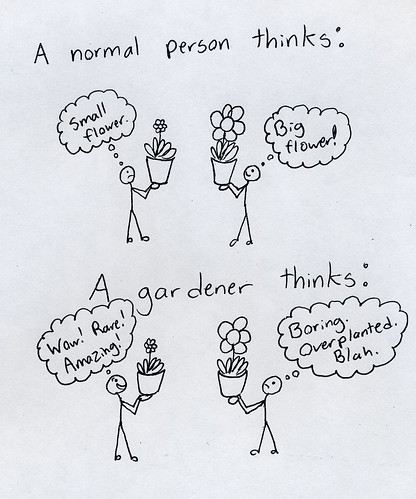Okay, so I made the Campanula week thing up. But I'm going to MAKE it national campanula week here on my blog with this post. If you blog, feel free to campanula things up with a post of your own.
I never used to grow campanula. I think just because they are SO many of them. Chiltern seeds, one of my favorite seed sources lists no fewer than
44 and the Arrowhead Alpines selection clocks in at
53. With that many to choose from, I never knew where to start, and just sort of flipped past those pages feeling overwhelmed.
But no more. This year I took the plunge with half a dozen, and I am rather smitten. Here are 4 of the most interesting.
Campanula carpatica
This is one of the standard little campanulas, and I have to say, it is pretty nice. Little dense plants that cover themselves with flowers round about mid-June, then keep on reblooming the rest of the summer. Not only that, but like all the rest of the genus, these have been absolutely tough and undemanding for me - they even put up with being transplanted in the middle of a 90 degree heat wave without wilting!
Campanula cochlearifolia 'Miranda'
This is a TINY little plant -- see the penny in the picture for scale -- and utterly adorable. I always worry that these little bitty things will be wimpy, but like all the others, it is proving to be as tough as nails. It is already showing signs of being a spreader, which I'm happy about. It is too small to overwhelm other plants, and I think it will make a lovely little ground cover.
Campanula takesimana 'Beautiful Trust'
This is one very odd little plant. Strange wiffle ball-like buds that open into sprawling octopus-like white flowers. Unique, yes. Beautiful? I'm not so sure, but the collector in me is happy to have it.
Campanula punctata 'Stevie Ray'
I like this one. A lot. The flowers are huge (my hand is in the second picture to give you an idea of the size), a graceful shade of blue, and produced in abundance. I dead-headed the first crop of blooms, and now it is beginning to reward me with another flush of them. C. punctata is generally supposed to be a fairly agressive spreader, but according to arrowhead alpines, this one isn't so much. Which is good, I guess. I don't like plants that take over, but this is one I wouldn't mind having a lot of.



